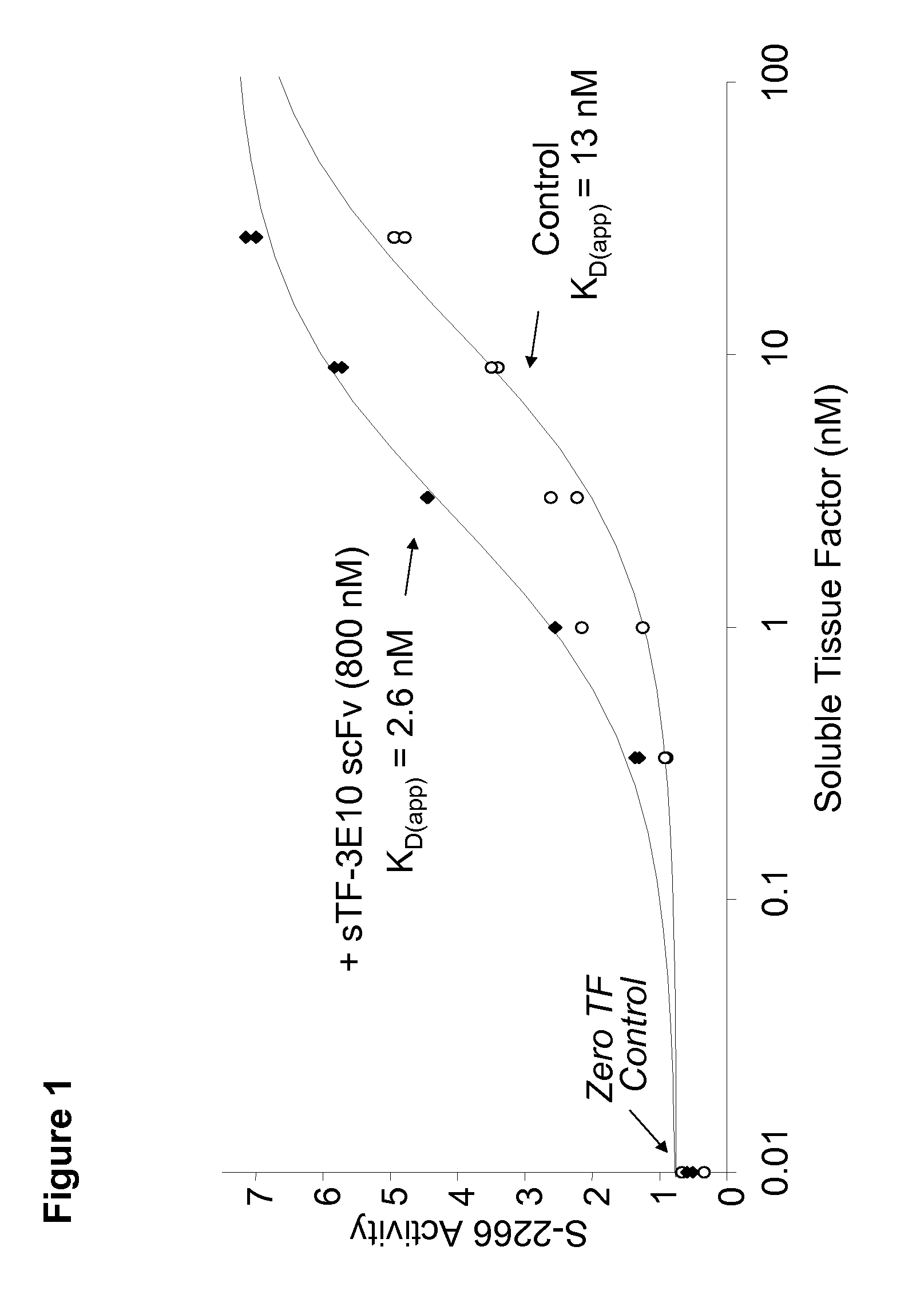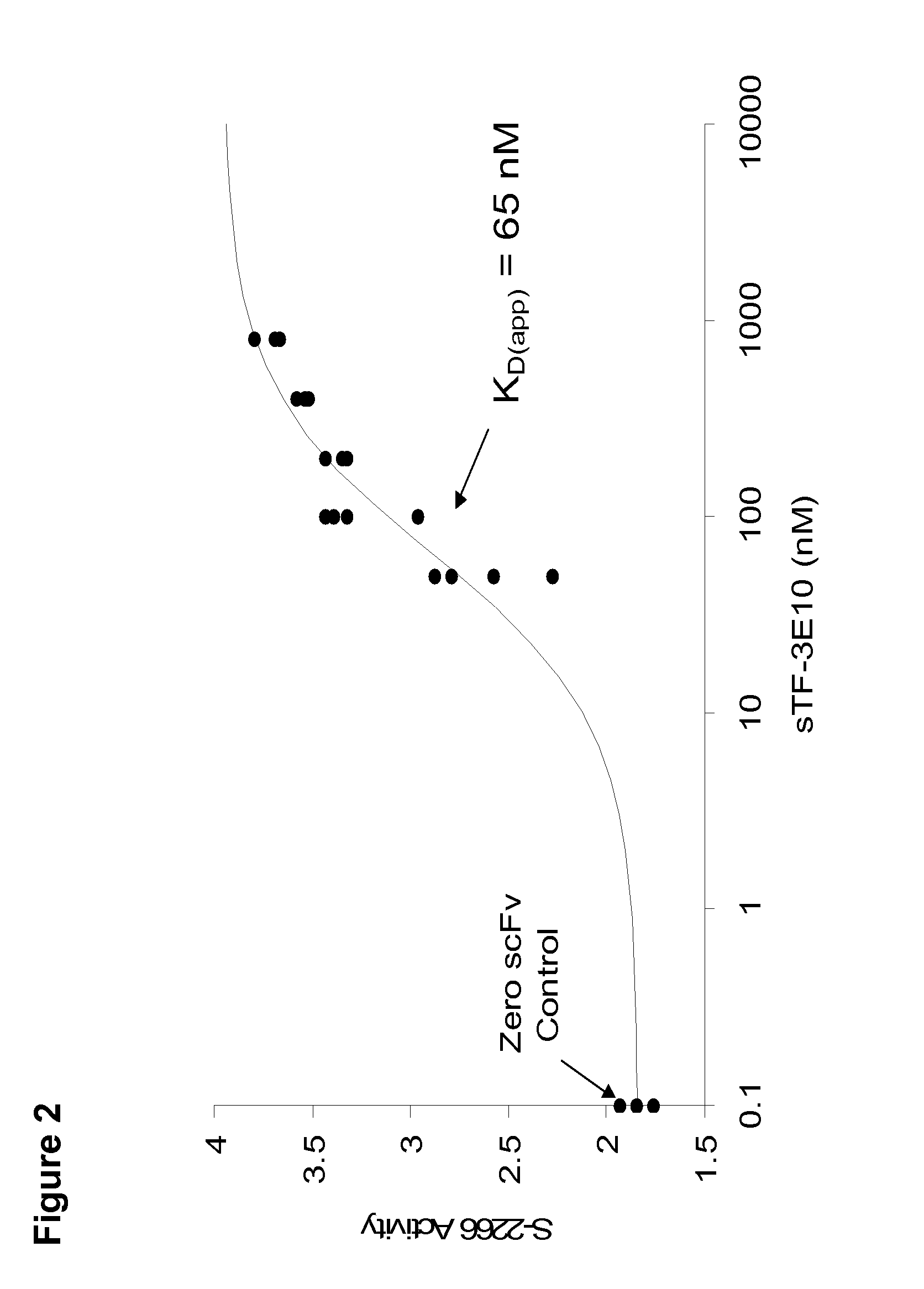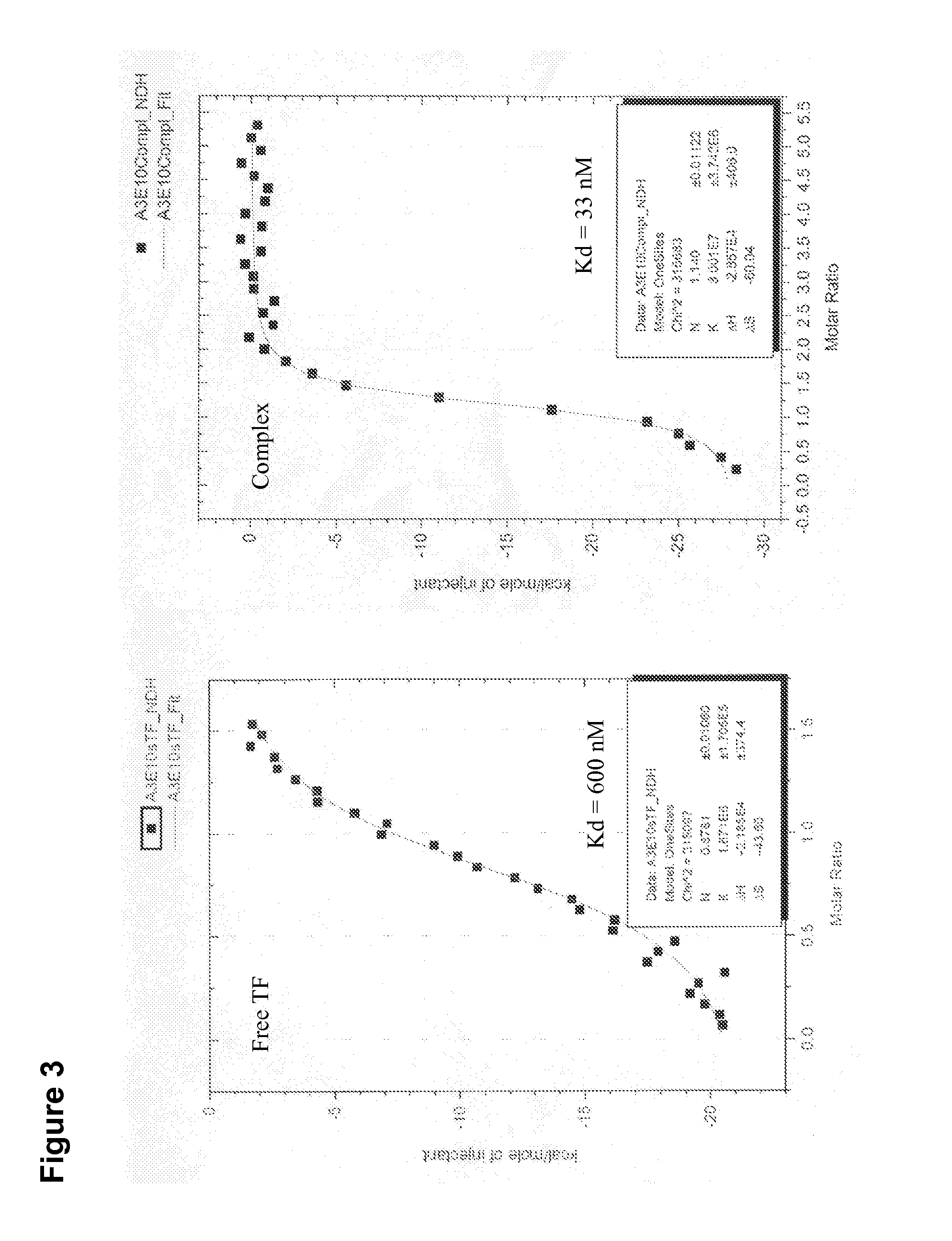Novel tissue factor targeted thrombomodulin fusion proteins as anticoagulants
a fusion protein and tissue factor technology, applied in the direction of fusion polypeptides, packaged goods types, peptide/protein ingredients, etc., can solve the problems of life-threatening thrombosis and/or contribute to pathological complications, venous thrombosis, stroke, etc., to inhibit the generation of thrombin
- Summary
- Abstract
- Description
- Claims
- Application Information
AI Technical Summary
Benefits of technology
Problems solved by technology
Method used
Image
Examples
example 1
Single Chain Anti-TF Antibody Construct scFv(TF)3e10
[0146]
(−18)MLGVLVLGALALAGLVFPEMAQVNLRESGGTLVQPGGSLRLSCAASGFSFTDAWMSWVRQAPGKELEWVSSISGSGGSTYYAGSVKGRFTISRDNSKNTLYLQMNSLRAEDTAVYYCARVLSLTDYYWYGMDVWGQGTLVTVSAGGGGSGAPNFMLTQPHSVSASPGKTVTISCTRSSGSVASYYVQWYQQRPGSSPTTVIYEDNHRPSGVPDRFSGSIDTSSNSASLTISGLKTEDEADYYCQSYDSNNLVVFGGGTKLTVLGAAAGAPVPYPDPLEPRAA(264)
[0147] The single chain anti-TF antibody scFv(TF)3e10 (SEQ ID NO:1) consists of a signal peptide (−18 to −1), VH domain (1 to 126), VH-VL linker (127 to 131), VL domain (132 to 246), and e-tag sequence (247 to 264).
example 2
Fusion Protein Construct 1—scFv(TF)3e10-TMi456
[0148]
(−18)MLGVLVLGALALAGLVFPEMAQVNLRESGGTLVQPGGSLRLSCAASGFSFTDAWMSWVRQAPGKELEWVSSISGSGGSTYYAGSVKGRFTISRDNSKNTLYLQMNSLRAEDTAVYYCARVLSLTDYYWYGMDVWGQGTLVTVSAGGGGSGAPNFMLTQPHSVSASPGKTVTISCTRSSGSVASYYVQWYQQRPGSSPTTVIYEDNHRPSGVPDRFSGSIDTSSNSASLTISGLKTEDEADYYCQSYDSNNLVVFGGGTKLTVLGAAAGGGGSGGGGSGGGGSVEPVDPCFRANCEYQCQPLNQTSYLCVCAEGFAPIPGEPHRCQLFCNQTACPADCDPNTQASCECPEGYILDDGFICTDIDECENGGFCSGVCHNLPGTFECICGPDSALAGQIGTDCAAAGAPVPYPDPLEPRAA(400)
[0149] The scFv(TF)3e10-TMi456 fusion protein (SEQ ID NO:2) consists of a signal peptide (−18 to −1), VH domain (1 to 126), VH-VL linker (127 to 131), VL domain (132 to 246), VL-TM linker (247 to 264), TMi456 domain (265 to 382), and e-tag sequence (383 to 400). The H381G, M388L, R456G and H457Q mutations in TMi456 are underlined.
example 3
Fusion Protein Construct 2—scFv(TF)3e10-TMi456Δ
[0150]
(−18)MLGVLVLGALALAGLVFPEMAQVNLRESGGTLVQPGGSLRLSCAASGFSFTDAWMSWVRQAPGKELEWVSSISGSGGSTYYAGSVKGRFTISRDNSKNTLYLQMNSLRAEDTAVYYCARVLSLTDYYWYGMDVWGQGTLVTVSAGGGGSNFMLTQPHSVSASPGKTVTISCTRSSGSVASYYVQWYQQRPGSSPTTVIYEDNHRPSGVPDRFSGSIDTSSNSASLTISGLKTEDEADYYCQSYDSNNLVVFGGGTKLTVLGAAAGGGGSGGGGSGGGGSVEPVDPCFRANCEYQCQPLNQTSYLCVCAEGFAPIPGEPHRCQLFCNQTACPADCDPNTQASCECPEGYILDDGFICTDIDECENGGFCSGVCHNLPGTFECICGPDSALAGQIGTDC(379)
[0151] The scFv(TF)3e10-TMi456Δ fusion protein (SEQ ID NO:3) consists of a signal peptide (−18 to −1), VH domain (1 to 126), VH-VL linker (127 to 131), VL domain (132 to 243), VL-TM linker (244 to 261), and TMi456 domain (262 to 379). The H381 G, M388L, R456G and H457Q mutations in TMi456 are underlined.
PUM
| Property | Measurement | Unit |
|---|---|---|
| volume | aaaaa | aaaaa |
| pH | aaaaa | aaaaa |
| pH | aaaaa | aaaaa |
Abstract
Description
Claims
Application Information
 Login to View More
Login to View More - R&D
- Intellectual Property
- Life Sciences
- Materials
- Tech Scout
- Unparalleled Data Quality
- Higher Quality Content
- 60% Fewer Hallucinations
Browse by: Latest US Patents, China's latest patents, Technical Efficacy Thesaurus, Application Domain, Technology Topic, Popular Technical Reports.
© 2025 PatSnap. All rights reserved.Legal|Privacy policy|Modern Slavery Act Transparency Statement|Sitemap|About US| Contact US: help@patsnap.com



